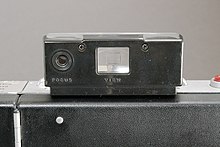Rangefinder camera
A rangefinder camera is a camera whose optical viewfinder is equipped with a focusing aid that is linked to the distance setting of the lens . This rangefinder is usually designed as a cross- sectional rangefinder or a mixed image rangefinder .

Cameras that support the use of interchangeable lenses usually also offer an adjustment of the viewfinder image to the focal lengths of the lenses.
In most cases, this is done by fading bright lines into the viewfinder image. The frames indicate the limits of the exposure to match the respective focal length.
history
The first rangefinder camera according to the above definition was that of Zeiss Ikon from 1936 built Contax II. The best known (and until now built) mm camera of this type is the Leica M . Numerous other designs have disappeared from the market , primarily due to the widespread use of single-lens reflex cameras in the 1970s. In the mass market, rangefinder cameras have been completely replaced by compact cameras with autofocus .
Based on the Leica standard, there has been a whole series of new rangefinder cameras manufactured by Konica and Cosina (Hexar, Voigtländer Bessa, Epson R-D1, Zeiss Ikon , Rollei 35RF). In the medium format there are the Mamiya 6 and 7 or 7II rangefinder cameras with interchangeable lenses . Former manufacturers of rangefinder cameras were u. a. Nikon (S series, whereby two models, S3 and SP, were newly manufactured a few years ago in limited special editions), Canon ( Canonet ), Olympus (XA series with built-in lens), Zenza-Bronica (with the RF645) and Minolta (in cooperation with Leica, CL and CLE ). Contax, the inventor of this type of camera, even attempted a new entry into the market with the G-System in 1994, more than 30 years after the end of the production of rangefinder cameras, which ended in 2005 with the withdrawal of the parent company.
advantages
The concept of the rangefinder offers several advantages over the widely used SLR cameras.
The mirror of the single-lens reflex camera is no longer needed, so the viewfinder image is permanently visible, even during long exposure times, and the vibrations that arise from an oscillating mirror and lead to blurring with long exposure times are avoided. After all, the triggering sound of a rangefinder camera is usually quieter than that of a single lens reflex camera.
A bright rangefinder enables precise focusing even under such light conditions that the focusing screen of a mirror reflex no longer shows a clear picture and many autofocus systems no longer focus.
Another advantage is the small size. The rangefinder cameras are not only easier to transport, but also have a less intrusive effect on the people being photographed. Many convinced users of rangefinder cameras emphasize the fact that with the rangefinder camera, the intimacy between the photographer and the person depicted suffers less than with relatively noisy SLR cameras. Taking pictures with the rangefinder camera can therefore be more discreet.
The smaller flange focal length compared to a single lens reflex camera (since no space is required for a mirror that can be folded away) enables more compact lens designs with the same focal length. In addition, it is easier to build high-quality imaging wide-angle lenses, since retrofocus constructions can be dispensed with.
disadvantage
The separation of the taking lens and viewfinder results in a slightly different angle of view. This effect is also called parallax . The parallax means that for objects that are closer than about three meters in front of the camera, the section can no longer be determined precisely, i.e. H. the final photo no longer exactly matches the viewfinder image. Modern rangefinder cameras compensate for this parallax by, for example, moving the bright lines in the viewfinder to match. Simpler constructions are satisfied with the well-known parallax markings in the viewfinder, which are mostly aimed at the smallest distance setting. Intermediate values must be estimated.
Furthermore, the use of lenses with different focal lengths is difficult. Either the different focal lengths are displayed again by bright frames within the viewfinder, or the angle of view of the selected focal length can be traced with the help of a clip-on viewfinder. An exception was the Contax G with a "real image viewfinder" that automatically adjusted to the selected focal length. When using clip-on viewfinders, on the other hand, it is first necessary to focus using the rangefinder and then to define the image section using the clip-on viewfinder. Quickly taking pictures of moving objects becomes extremely difficult here.
In addition, due to the design, the use of focal lengths longer than 135 mm (small picture) is problematic, since the corresponding viewfinder frame would be very small and exact image composition and focusing would be extremely difficult; the only alternative would be to choose such a large viewfinder magnification that on the other hand the use of wide-angle lenses would be practically impossible. For this reason, Leica had the so-called Visoflex on offer for many years ; other manufacturers (such as Contax, Voigtländer and Zeiss Ikon) do not offer any lenses with a focal length longer than 90 mm.
Digital rangefinder cameras
The first digital rangefinder camera was the Epson R-D1 from 2004, of which various variants with minor revisions appeared until 2009. In 2006, Leica introduced its first M series digital camera, the M8 . In September 2009 the Leica M8 (and M8.2) was replaced by the M9 with a small image sensor. The Leica M10 is now the current camera of this type; With the Monochrom , Leica manufactures a camera that records exclusively in black and white. With the X100, Fujifilm began manufacturing cameras in 2010 that are based on optical digital rangefinder cameras. To be called a rangefinder camera, they lack the focusing aid via a linked range finder. This was followed by the Fujifilm X-Pro1 2012, the Fujifilm X100S 2013, the Fujifilm X100T 2014 and the Fujifilm X-Pro2 2016.


